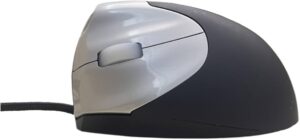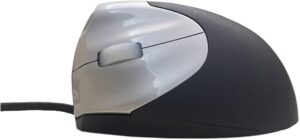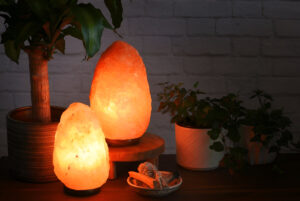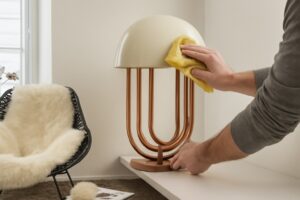How to clean a Salt Lamp? Similar to how I found the ideal balance between style and functionality while researching how to clean a mid-century modern lamp, the soft amber glow of a Himalayan salt lamp has a unique ability to turn any area into a peaceful haven. Salt lamps require their own special maintenance, much like cleaning brass lamps or vintage candlestick lamps require precision. Carved from ancient salt deposits that formed millions of years ago, these crystalline treasures are more than just ornamental items; they are living, breathing things that have fascinating interactions with their surroundings. Salt lamps have hygroscopic qualities that make them challenging to maintain, requiring a careful balancing act between maintaining their longevity and maintaining their natural beauty. This is in contrast to your typical Stiffel lamps or modern terracotta table lamps.
Step 1: Maintaining Your Himalayan Salt Lamp
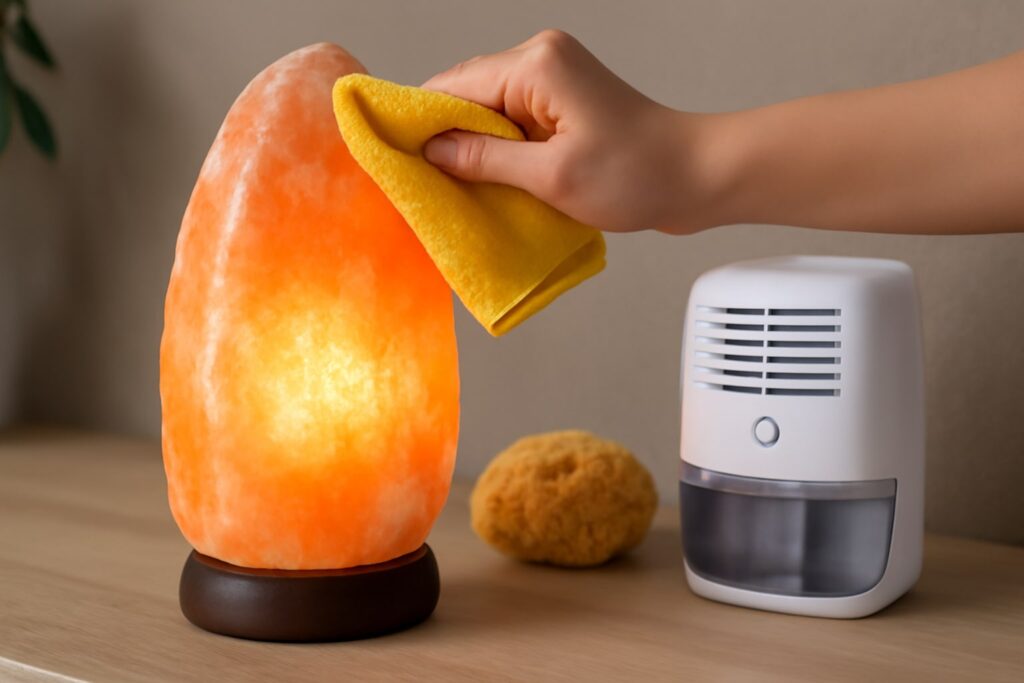
The first step in taking good care of your salt lamp is to understand its special characteristics. Each lamp is a geological masterpiece, crafted from Himalayan salt deposits that formed more than 250 million years ago. Your lamp may “weep” or seem to melt in humid conditions because salt has hygroscopic qualities, which allow it to naturally absorb moisture from the surrounding air.
The following are essential products for maintaining Himalayan salt lamps:
- Premium Microfiber Cleaning Cloths – Search Amazon for lint-free options that won’t scratch the salt surface
- Natural Sea Sponges – Specially made for delicate cleaning tasks
- Dehumidifier – For high-humidity environments to reduce excessive moisture absorption.
Understanding that your salt lamp is just doing what salt does naturally, rather than melting, is the key to maintaining it. Your lamp will start to absorb water molecules from the air when the humidity level reaches 60%, which may cause droplets to collect around the base. This process, known as hygroscopy, is perfectly normal and shows that the salt in your lamp is real Himalayan salt and not a fake.
Keeping your lamp lit for at least 16 hours every day—ideally, all day—is part of routine maintenance. Your lamp stays dry and stable because of the evaporation effect caused by the bulb’s mild heat, which prevents moisture absorption. Additionally, this continuous warmth improves the lamp’s capacity to emit negative ions, which many people think enhances air quality and general health.
Step 2: Protect Your Salt Lamp from Moisture Damage
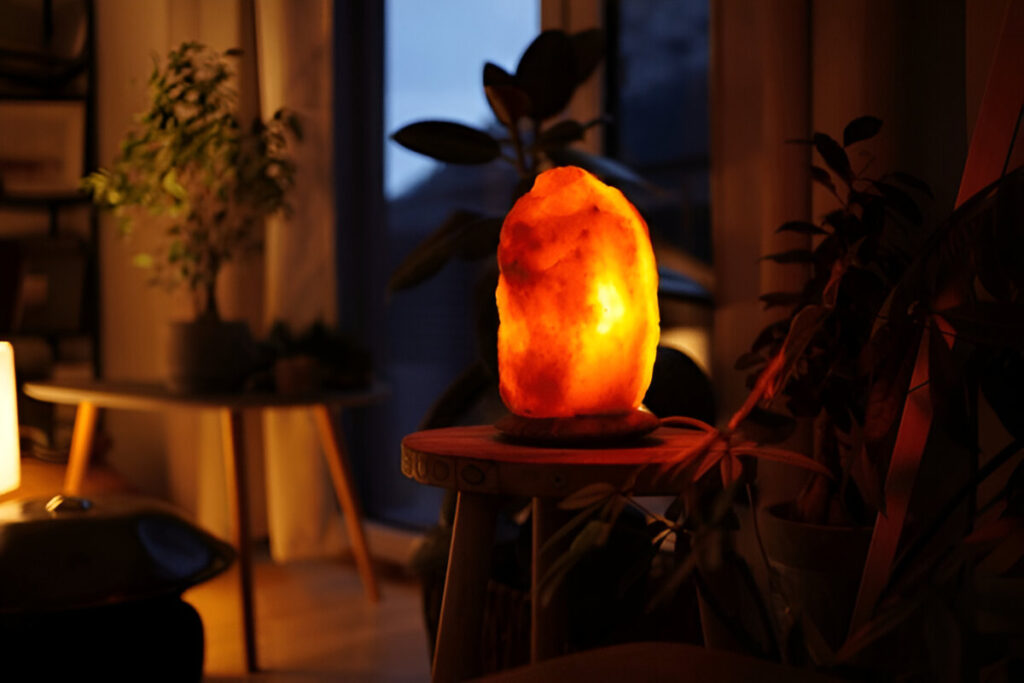
Environmental Control and Location Strategy:
The first step in preventing moisture damage is strategically placing your salt lamp. Avoid placing your lamp near windows or in areas with significant humidity fluctuations, such as bathrooms or kitchens. Your lamp is exposed to too much moisture in these places, which may exceed its capacity for natural evaporation and cause structural damage or ongoing weeping.
The following products are suggested for moisture prevention:
- Digital Hygrometer: Keep an eye on the room’s humidity levels (ideally between 40 and 60 per cent).
- Lamp Plates for Protection: Waterproof bases to prevent possible drips on furniture.
- Higher Wattage Bulbs: For humid climates use 25W or more bulbs instead of the typical 15W ones.
Keeping the temperature and humidity levels constant is essential to creating the ideal atmosphere. If you live in an area with high humidity levels, consider purchasing a room dehumidifier to keep the air between 40 and 60 per cent relative humidity. This range offers the ideal balance so that your salt lamp can work efficiently without absorbing too much moisture.
Upgrading to a higher-wattage bulb can increase the evaporation power of homes located in coastal regions or areas with high seasonal humidity. During humid months, switching to a 25W or even 40W bulb can significantly reduce moisture-related issues, even though standard 15W bulbs function well in most situations. Before making this change, always make sure the electrical parts of your lamp can withstand the higher wattage.
Step 3: Salt Lamp Storage Best Practices
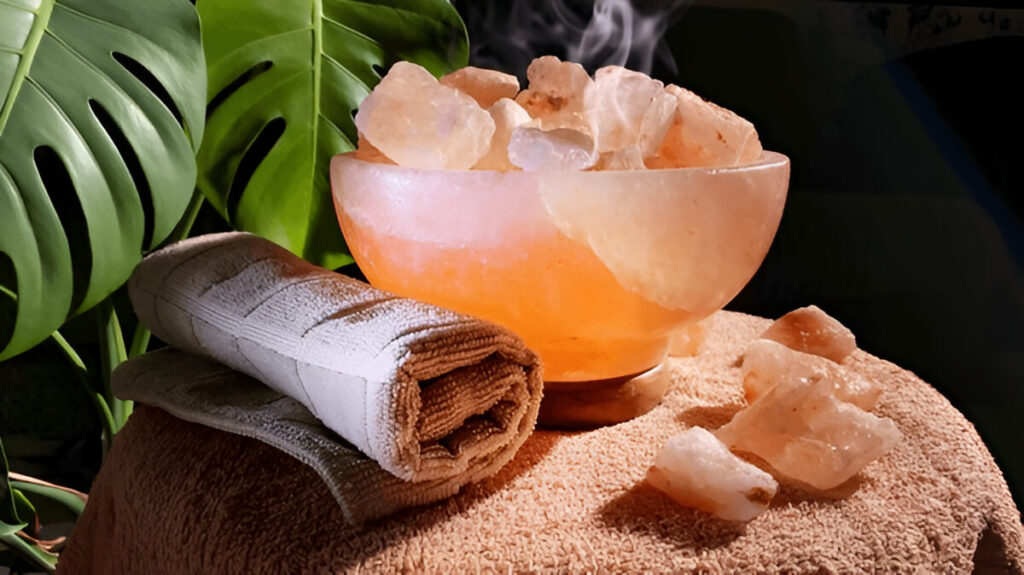
Seasonal Storage and Extended Maintenance:
Being prepared before storing your salt lamp for an extended period will help prevent damage and guarantee that it stays in perfect condition for many years to come. The lamp’s natural crystalline structure must be preserved during storage by using protective wrapping techniques and paying close attention to moisture prevention.
Amazon Storage Essentials:
- Vacuum-Sealed Storage Bags: Provides an airtight environment to prevent moisture infiltration
- Silica Gel Packets: Extra moisture absorption for extended storage
- Bubble Wrap: Cushioning that protects the fragile salt crystal
Before starting the storage preparation process, make sure your lamp is completely dry and at room temperature. To avoid damage, carefully remove the electrical cord and bulb and store them separately. Make sure the lamp is completely covered with plastic film or sealed in a vacuum-sealed bag to prevent any air pockets from letting moisture in.
Incorporate silica gel packets into the storage container to absorb any remaining moisture for seasonal storage during the humid summer months or prolonged travel times. Mark your storage container with the date and any special maintenance instructions to make future setup easy and stress-free.
Step 4: Essential Maintenance Guide
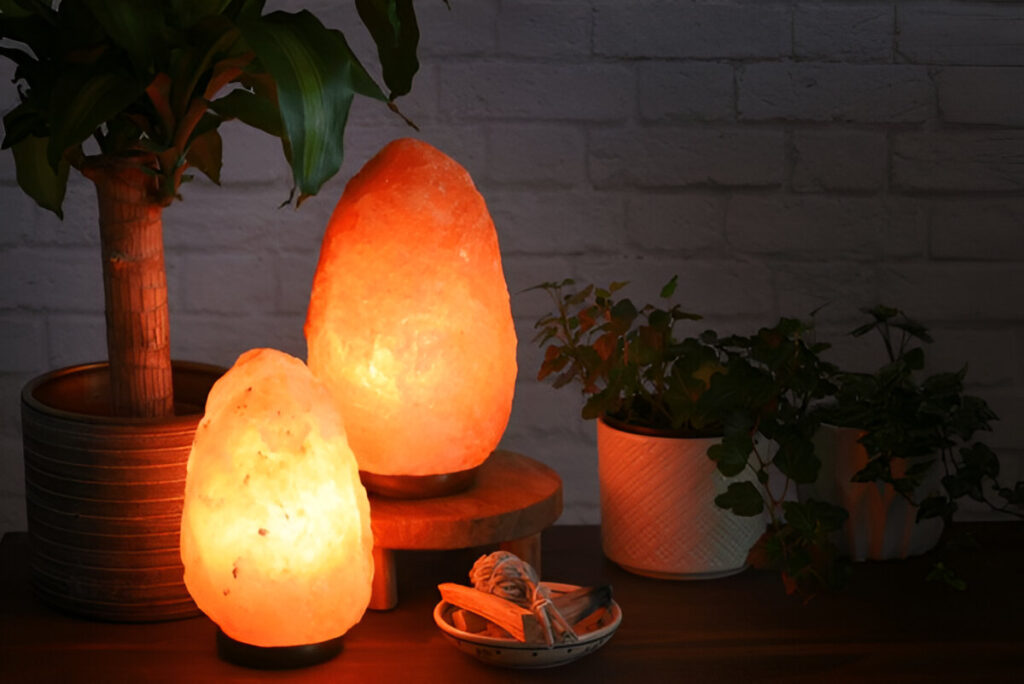
Routines for Weekly and Monthly Maintenance:
Establishing a regular maintenance schedule can prolong the life of your salt lamp and keep it looking nice. While monthly deep care guarantees peak performance and prevents common problems before they arise, weekly maintenance consists of visual inspection and light cleaning.
Expert Maintenance Equipment:
- Lint Roller: For thorough crevice cleaning without scratching
- Soft-Bristled Brush Set: Fast dust removal for smooth surfaces
- LED Inspection Light: Improved visibility during thorough cleaning procedures
Checklist for Weekly Care:
- Examine the base for any signs of moisture buildup.
- Examine the electrical cord for any signs of wear or damage.
- Use a dry microfiber cloth to gently dust any visible surfaces.
- Check that the lightbulb is working and producing warmth.
- If utilizing a hygrometer, keep an eye on the humidity levels in the room.
More thorough cleaning and inspection are part of monthly maintenance. Before starting, turn off the lamp and let it cool completely. Instead of using wiping strokes, use dabbing motions to gently wipe the entire surface with a microfiber cloth that is slightly damp but not wet. This method keeps the fabric from tearing or catching lint on the rough salt surface.
After cleaning, wipe off any remaining moisture with a completely dry cloth before turning the lamp back on. The bulb’s heat will evaporate any residual moisture, returning your lamp to its original glow. Record your maintenance tasks to monitor trends and spot emerging problems early.
Technical Analysis of the Ideal Weather for Salt Lamps
The ideal environmental conditions are:
Certain temperature and humidity levels are optimal for salt lamp operation, optimising both visual appeal and practical advantages. According to scientific research, salt lamps work best in regulated air conditions that strike a balance between the rates of evaporation and moisture absorption.
The temperature range is 68-75°F (20-24°C).
While avoiding overheating that can harm the salt crystal structure, this temperature range offers enough warmth to sustain evaporation. Higher temperatures can result in rapid expansion and possible cracking. In comparison, lower temperatures decrease evaporation efficiency and cause moisture to accumulate.
The range of relative humidity (RH) is 40–60%.
The sweet spot where salt lamps can absorb atmospheric moisture without over-absorbing is represented by this range. The lamp may become overly dry and brittle below 40% relative humidity, and excessive moisture absorption above 60% RH causes the lamp to weep continuously.
Moderate air circulation (0.5–1.0 m/s)
Gentle air movement avoids dust accumulation and improves evaporation. Static air lowers evaporation efficiency, and strong drafts can induce temperature swings that stress the salt crystal.
Scientific Reasoning:
Because salt is a hygroscopic substance, it constantly exchanges moisture with its surroundings through a vapour pressure differential. Visible weeping results from moisture absorption that speeds up beyond the lamp’s evaporation capacity when atmospheric humidity surpasses the salt’s equilibrium point, which is roughly 75% RH for pure sodium chloride.
Higher surface temperatures cause evaporation to increase exponentially, according to the mathematical formula Evaporation Rate = k × (Tsurface – Tambient) × Surface Area. This explains why the vital thermal energy required for moisture balance is maintained when lamps are kept lit.
Step 5: Troubleshooting Common Salt Lamp Issues
Identifying and Resolving Performance Problems:
Even with the right maintenance, salt lamps can occasionally experience problems that call for particular troubleshooting techniques. By being aware of these issues and their solutions, minor issues can be avoided, turning into major repairs or replacements.
Advanced Troubleshooting Kit:
- Multimeter: Electrical continuity and bulb functionality tests
- Replacement Bulb Variety Pack: Different wattages for various circumstances
- Electrical Contact Cleaner: Eliminates corrosion from light fixtures
Problem: Excessive Sweating/Weeping
This means that the humidity in the air is higher than what your lamp can evaporatively handle. Moving to a drier location, upgrading lightbulbs, or installing dehumidifiers to regulate the moisture in the air are some solutions. A professional evaluation of your home’s HVAC system may be necessary if you experience persistent weeping.
Problem: Hard Salt Buildup at Base
When dissolved salt dries without adequate evaporation, this crystallization happens [Reddit reference from user content]. To fix it, turn off the electricity, use a syringe or spray bottle to apply warm (not hot) water to the affected area, let it dissolve for ten to fifteen minutes, and then gently scrub with a soft brush. Dry completely before re-establishing power.
Problem: Flickering or Non-Functional Bulb
Bulb failure or loose connections are common causes of electrical problems. First, make sure the lightbulb is correctly seated in the socket and hasn’t moved during movement. If the flickering continues, examine the bulb for the distinctive smoky film that denotes internal damage. To ensure appropriate heat generation, replace with equivalent wattage specifications.
Problem: Surface Discoloration or Dullness
Over time, surface alterations may result from natural oxidation. Using a cloth wrung to a “damp dry” consistency, use steaming hot (not boiling) water by the hot water refresh technique (which is similar to the video transcript provided). While the heat stops the oxidized layer from absorbing too much moisture, work quickly to remove it. With this method, a thin layer of salt is literally removed, exposing new crystals underneath.
Frequently Asked Questions
Dust your Himalayan salt lamp once a week and clean it once a month with a moist cloth. To avoid moisture-related problems in high-humidity environments, increase the frequency of cleaning to once every two weeks.
Salt lamps can become permanently discoloured and damaged if soap, bleach, or chemical cleaners are used on them. For all cleaning tasks, use only microfiber cloths and plain water.
Excessive moisture absorption causes dissolved salt to crystallize, leaving behind a white residue. Although this is common in humid environments, it can be lessened by lowering ambient humidity and leaving the lamp on for more extended periods.
Since salt is a stable mineral that never goes bad, genuine Himalayan salt lamps can last for a very long time with the proper maintenance. Replacement will only be necessary in the event of physical damage or electrical component failure.
Indeed, salt lamps are made to run continuously and benefit from continuous light. The heat improves the lamp’s air purification capabilities and stops moisture absorption. Modern LED bulbs operate cost-effectively around the clock because they consume very little electricity.
If your lamp becomes overly saturated, turn off the electricity immediately and let it dry completely in the sun or another warm, dry place. Depending on the saturation level, this could take a few days. Avoid using direct heat sources, such as ovens or hair dryers, to speed up drying.
Salt lamps are only meant for indoor use. Exposure to rain, humidity, and temperature changes outdoors can cause rapid deterioration and possible electrical hazards.
Genuine lamps have a rough texture, natural colour variations, and the ability to absorb moisture. When lit, they should have a warm, amber glow and feel substantial in weight. The colour and texture of fake lamps are frequently too consistent.
For typical conditions, 15W bulbs are advised; however, humid environments might benefit from 25W or more bulbs. To avoid overheating or electrical damage, always check the electrical specifications of your lamp before increasing the wattage.
Although there is still disagreement over the scientific basis for air purification, salt lamps do have the ability to hygroscopically absorb moisture and certain airborne particles. The psychological effects of warm, calming light and the aesthetic ambience are the main advantages.
